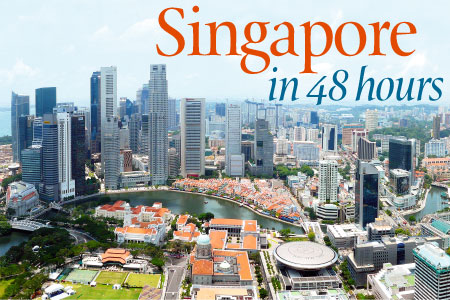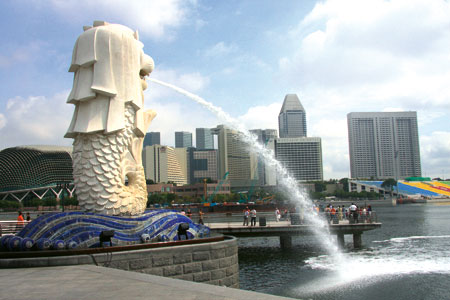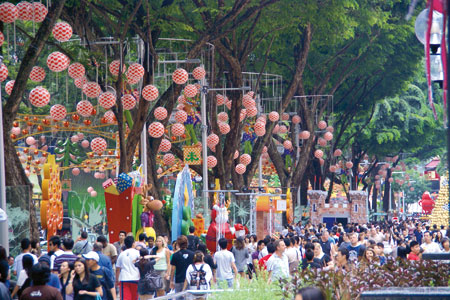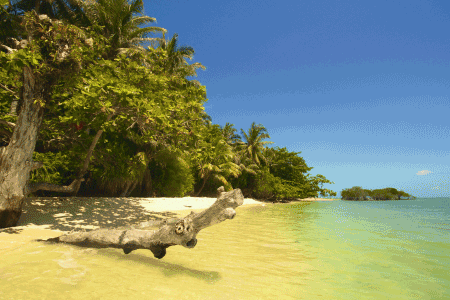
Travel Feature - Singapore in 48 Hours
Issue 77 February 2011
Take a journey to uncover the contrasting personalities of Singapore, and get away from it all in the South China Sea.
Words and Photography Nabeel Shariff
It was truly a first. Within 15 minutes of disembarking my plane at Singapore’s Changi Airport, I was on my way out of the arrivals hall. If only everywhere was this efficient! I thought I was about to wake up from my wanderlust daydream, but it was 10.15am and I was off to find the Mass Rapid Transit (MRT), the über-resourceful way to get around this unique city.
As I began to approach the busier metro terminals, the streams of quirky Singaporeans filtered amongst the array of sharply dressed teenagers kitted out with the latest iPod accessories and mobile apparel made me feel somewhat behind the times. From the organised chaos of London streets, this was a strange utopia where every waste bin is meticulously positioned and all signs concise and understandable. Clearly, I became immersed in the world of obsessive perfection planned by Sir Stamford Raffles, as I shuttled into my hotel stop in the busy district of Chinatown.
Some may wonder why I’m staying in Chinatown instead of the sleek centres of Orchard Road or Clarke Quay. Well, I’m a foodie and the Maxwell Centre delivers the heartiest brunch anywhere in Singapore. Accessed via Chinatown or Tanjong Pagar MRT, the collection of over 50 hawker stalls is open 24 hours, and the best place to find a quick fix for a nasi goreng craving. Most dishes are between £1-3, which makes eating out cheap and cheerful, as well as a great place to people watch. Ironically, my hotel for the next couple of nights is The Scarlet, located a few minutes walk from the Maxwell Centre. This eccentric and charismatic boutique hotel is not quite like your regular chain resort. Each room is different, exuding a boudoir feel, with subtle personal touches.

The city is famous for its four quarters; Arab, Malay, Chinese and Indian, where traders from all regions converged in the 19th and 20th centuries.
If you can bear to drag yourself away from the hotel (and the cool doorman who bears an uncanny resemblance to Jermaine Jackson), the best way to see Singapore is using a combination of the metro and on foot. The MRT costs around $2 (about £1) for a one way fare, but if you’re relying on the MRT then a two day pass costing $26 (approximately £13) per person is much better value. A few stops south of Chinatown is the aptly named Raffles Place, home to the founder of the city. Throughout a life of military expeditions, Anglo-European negotiations, battling against the slave trade and of course a knighthood, Sir Stamford Raffles is where Singapore all started. Sculpted by Thomas Woolner, the statue at the Raffles landing site marks the spot where Sir Stanford stepped ashore in 1819. His legacy of turning a semi-chaotic trading port into a seamless organised city remains today. The city is famous for its four quarters; Arab, Malay, Chinese and Indian, where traders from all regions converged in the 19th and 20th centuries. After a short walk along Merlion Riverside and Esplanade Park, home to the Cenotaph, I was off to Little India.
The colourful streets of Little India merge into the Arab Quarter in one direction and the Malay Kampung in another, with the food stalls morphing from Dosa huts to Malay Biryani stands along the way. As the city is so ethnically diverse, if you’re lucky enough to be there during Eid, Diwali or as I was even during Christmas, you’re bound to stumble across some of the festivities. The influential architecture and vibrant colours seam through the consistently clean streets. Muslims enter mosques for afternoon prayers whilst tourists gape at the Hindu temples a few metres down the street, with locals having lunch in between. The shop houses on Muscat Street boast French wooden veneer windows, still in fine condition and each defining its own unique character. Meandering through the cultural melting pot for a few hours brings you back towards the riverside, a perfect vantage point as dusk approaches.

For street markets, head to Chinatown or Bugis Junction where you can find just about anything, along with the renowned S$1 fruit juice stalls.
Clarke Quay by twilight morphs from a sleepy episode of Balamory into a lively hotspot crammed with locals and tourists alike, all sampling the incredible seafood. There are numerous eateries, many with the infamous Singapore Chilli Crab on display and cooked in front of you whilst you watch the sun drift across Robertson’s Quay. Here, you can delve into as much or as little entertainment as you want, however the focus is on food. Singaporeans are enormously easy-going people with an equally immense appetite; however, be aware that many restaurants close at 10pm sharp, with only a few open till the small hours of the morning.
With the night firmly set in, Singapore keeps its vibrancy alive with plenty to do as the lights come on. A popular visit is the Singapore Zoo, where they open the doors to visitors to see their nocturnal inhabitants during the Night Safari.
For street markets, head to Chinatown or Bugis Junction where you can find just about anything, along with the renowned $1 fruit juice stalls. For more fashion and upmarket brands, then Orchard Road is the place to go with mall after mall lining Singapore’s arterial road. The newly opened ION Orchard and the Ngee Ann City are two popular shopping centres, with plenty going on during the day inside and out.
Many visitors use Singapore as a stopover hub to their onward destination; however, you can easily spend three or four days in this eclectic city. With much of the city sightseeing done the day before, I decided to head to nearby Sentosa Island. I wasn’t sure what to expect, however it certainly lived up to its reputation of being Asia’s playground. Home to eleven hotels, three beaches, a host of attractions and a Universal Studios, it was a further twist on this city’s diverse personality. Sentosa Island adds to the family friendly sentiment Singapore provides and there is no doubt there are days of exploring to be had on this small man-made island. As tempting as that sounded, I was more interested in getting away to somewhere quieter, a bit more Robinson Crusoe-esque.

From sailing to fishing and everything in between, Yogi and the Nikoi staff will make you feel part of the family. After the fast-paced lifestyle of Singapore, Nikoi is a vivid contrast, but this stunning island hideaway gives you the best of both worlds.
Located south of Singapore, off the island of Bintan lies Nikoi Island. After a 45-minute ferry to Bintan and an hour transfer across the island to another quick boat transfer, my secret hideaway location started to reveal itself. After leaving the shadowy shores of Bintan’s rural coast, the ocean turned an azure blue, the clouds lifted and we sailed into the South China Sea. Twenty minutes later Nikoi Island unveiled itself, like a Famous Five hideaway, and all at once the white shores of Nikoi seemed oceans away from vibrant Singapore. As I jumped off the boat into the shallow water, a gentleman named Yogi dressed in the Nikoi ‘uniform’ of shorts and a t-shirt greeted me with a huge smile. This pretty much set the tone for the next 48 hours: a barefoot lifestyle without a care in the world.
With fifteen hectares of private island, Nikoi is an eco resort ringed by pristine coral reefs and a coastline studded with magnificent white granite boulders separated by valleys of white sandy beach. Rising to a height of 30 metres, the island is also home to a rainforest ecosystem, where guests can walk along the lightly marked paths to view local birdlife and a few creepy crawlies such as Giant Snails and lizards. The design of the twelve two-story beach houses reflects both traditional Indonesian and contemporary architecture, using driftwood and thatching on the roof. There is no air conditioning as the clever design of the chalets allows air to naturally ventilate, keeping the rooms cool. Solar panels heat guests’ water, use of plastic is limited and the local island communities have been involved in the building and running of Nikoi. Nikoi sets a high benchmark in a truly eco-conscious resort in a natural setting, teeming with wildlife.
The central beach house is the communal area of Nikoi, housing the eating area and the fruit bar, which is also home to local bats during the night. There is no running electricity on the island, just a generator running during the day. At night, giant oil torches light up the island, and you almost feel you’re in an episode of Lost wandering back to your chalet after dinner. Nikoi focuses on using the elements of nature to create the ambience of rustic chic, in a down to earth, unpretentious manner.
For the more active, there is still plenty to do; the expansive pool looks over the South China Sea, and the coral reefs around the island make it a great place to snorkel. From sailing to fishing and everything in between, Yogi and the Nikoi staff will make you feel part of the family. After the fast-paced lifestyle of Singapore, Nikoi is a vivid contrast, but this stunning island hideaway gives you the best of both worlds.
Flight time from London to Singapore
13 hours direct flight
The Scarlet Hotel
rates start from £60 per person, per night
www.thescarlethotel.com
Nikoi Island
Rates start from £120 per person, per night
For more information contact Singapore Tourism on 0207 484 2710
Bookmark this |
|
Add to DIGG |
|
Add to del.icio.us |
|
Stumble this |
|
Share on Facebook |
|
Share this |
|
Send to a Friend |
|
Link to this |
|
Printer Friendly |
|
Print in plain text |
|


Comments
2 Comments
1
22 Sep 12, 02:24
I want to go to the singapore !!!!!!!!!!!
2
Faruque
9 Feb 11, 07:48
i love singapore